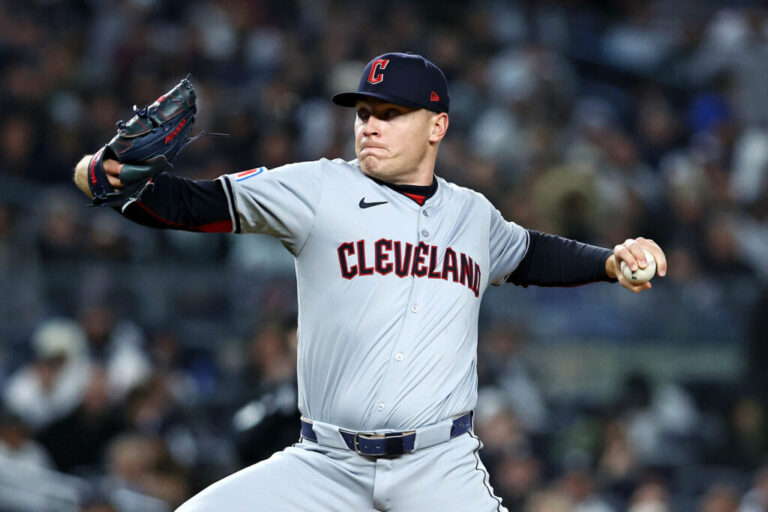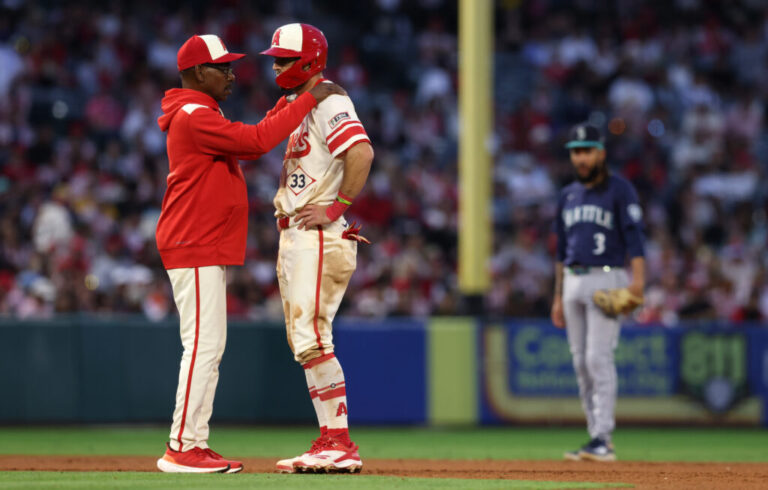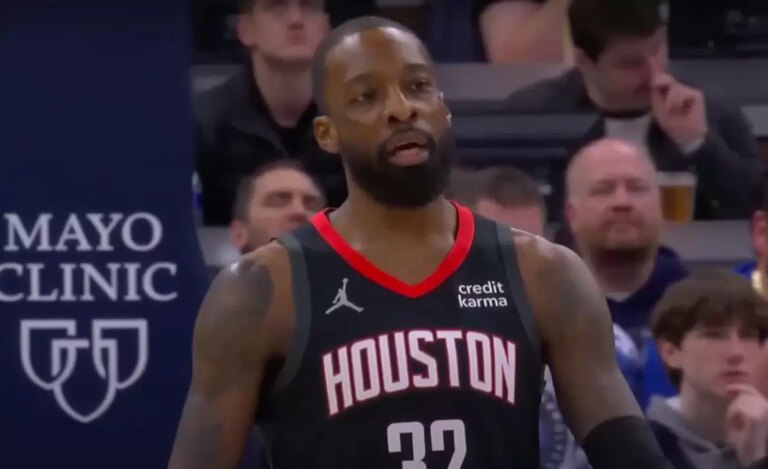
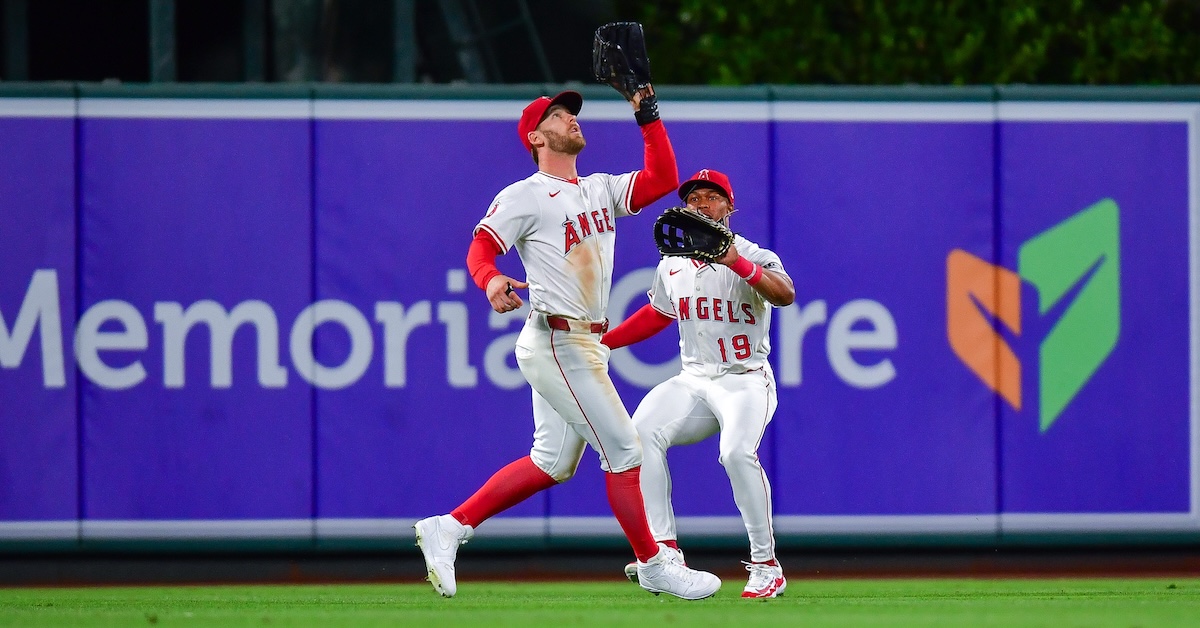
Welcome to another edition of Five Things I Liked (Or Didn’t Like) This Week. I got a chance to see many of my favorite baseball happenings this week: catchers making tough plays, exciting pitching matchups, and stars of the game at their absolute best. We also have plenty of goofy but delightful coincidences, just as Five Things patron saint Zach Lowe intended. A quick programming note: I’ll be on vacation, a nice restorative pre-deadline trip, for the next week and change. Enjoy baseball in the meantime – it’s a wonderful time of year for it.
1. Athletic Catchers
It’s amazing how much baseball knowledge your brain absorbs without actively thinking about it. For example, when you see an outfielder throw the ball home to cut down a runner trying to score on a single, you’ll immediately anticipate that the batter who hit that single might try to advance to second base. You might not even realize you’re thinking this. It’s just the natural timing of the sport. Long throw, cutoff man missed — how in the world is the catcher going to attempt a tag and then find a way to get the ball down to second base? It just doesn’t happen.
Or, well, it’s not supposed to happen. But Carlos Narváez doesn’t care what heuristics are stored in your brain:

What a weird play. The Red Sox correctly played to prevent the runner from scoring, and that let Wilmer Flores round first and get a great look at the play at the plate to see if he should advance. Right around this point, Narváez seemed to have no shot at throwing out Flores:
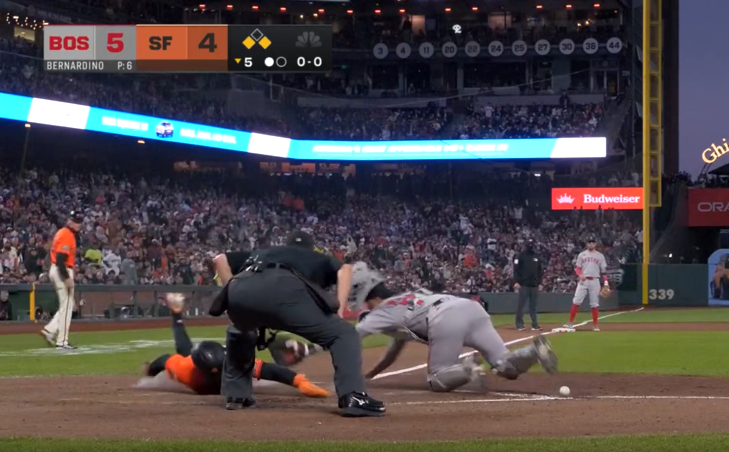
He lunged for the tag and lost the ball. Imagine how difficult it would be to get a throw off after being in this position — facing the wrong way, ball nowhere to be found, momentum carrying you in the opposite direction. I completely understand why Flores took off there. That’s just responsible baserunning; when the catcher goes to the ground and loses the ball, you’re supposed to take the free base.
Narváez didn’t give up, though. He didn’t even hesitate. When he didn’t catch the ball cleanly, he improvised, turning his sweeping tag attempt into an extended spin while looking for the ball. He located it and got his bearings. Luckily, it didn’t kick all that far away:

Even then, that was no easy play. Flores might not be fast, but he was decisive and had a head start. Look at where he was when Narváez first put glove to ball (as an aside, look at all the helpful Red Sox infielders!):
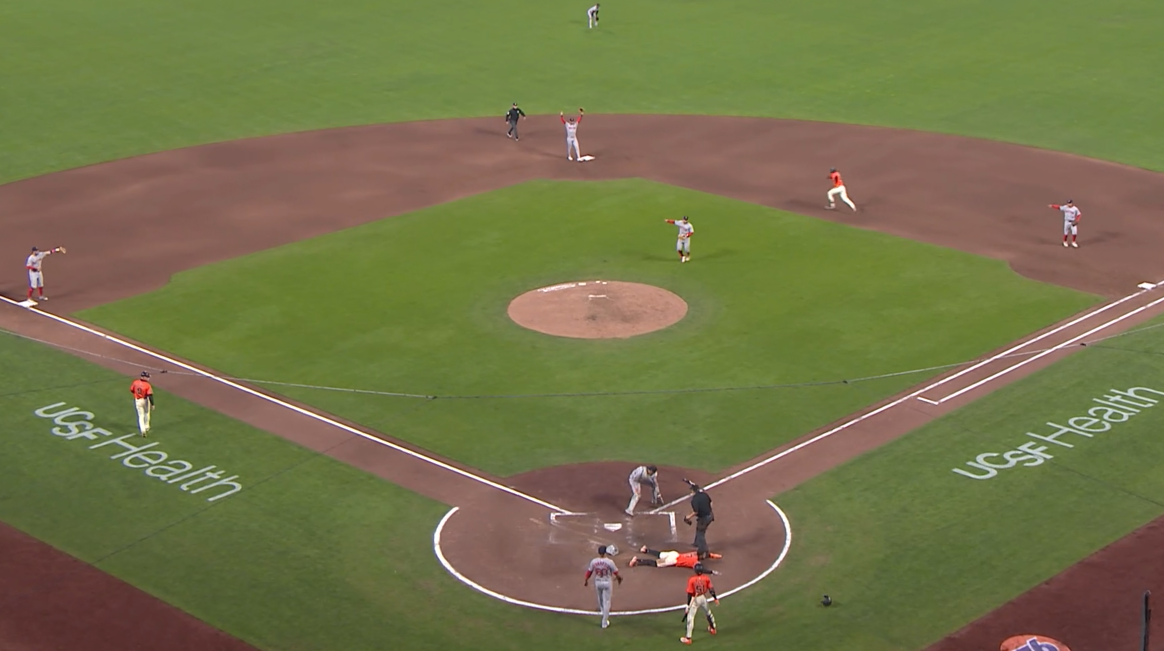
Narváez doesn’t have a huge arm, but he’s a tremendous asset in the running game anyway. His transfer is lightning fast, and he’s deadly accurate. The throw to Trevor Story was on the money, and Story made it count:

I’m not sure how defensive systems will handle that play. It doesn’t fall under stolen base prevention. It’s not really range or arm strength. The expected number of outs recorded from that spot is zero, as far as I’m concerned, and this play doesn’t happen often enough to have much of a cohort to compare to. But forget the systems, admire the hustle. Narváez has been one of the best stories in baseball this year, and as it turns out, he does the little things as well as the big ones.
2. Young Aces
Wednesday afternoon, I saw the future. Jacob Misiorowski and the Brewers hosted Paul Skenes and the Pirates, and for about 90 minutes, we got two glimpses into the nightmares of NL Central hitters. Misiorowski is only three starts into his major league career, but he’s already appointment viewing. Skenes isn’t a rookie anymore, but he’s also only 23. Heck, he was pitching in the College World Series just two years ago.
The crowd was a raucous sellout. The fastballs were absolutely electric. Misiorowski came out firing lasers, with 12 pitches above 100 mph in the first inning alone. He wasn’t dotting corners so much as throwing the ball through the opposition:

Skenes countered with some 100s of his own and this downright dastardly sequence to Christian Yelich:

It was all I could do not to laugh. How are you supposed to hit this stuff? Skenes snapped off a 97-mph splinker in the third inning. Misiorowski bullied poor Tommy Pham with this three-pitch sequence that included a 95-mph slider:

Of course, neither of these pitchers are perfect. Their flaws were on display even as they shone brightly. Misiorowski, whose blistering fastball and Elastic Man extension down the mound leave batters flummoxed and waving at air, sometimes struggles with command. He only walked two, but he ran a ton of deep counts, going only 74 pitches and five innings even as he struck out eight and allowed just two singles. He still hasn’t worked up to a full game’s workload in the majors yet, and based on his minor league numbers, he still needs to work on his strike throwing. The Pirates didn’t so much as threaten him, but they were still able to chase him from the game after a mere five innings.
On the other side of the matchup, Skenes’s two biggest question marks were in clear evidence. Though his stuff remains hellacious, his strikeout rate has dipped meaningfully this year. In the second inning, he couldn’t throw the ball past the Brewers. He faced nine batters without a single strikeout as they lunged to defend the plate and put the ball in play. It worked, and it worked particularly well because of the other question mark surrounding Skenes: the team around him.
The Pirates just couldn’t get it right in the second inning of this game. Infielders cheated over to help in the running game and left holes open for singles. Nick Gonzales played way in at second base against Caleb Durbin and couldn’t reach a soft liner as a result. Oneil Cruz failed to track down a flare, then overran it, allowing Brewers backup catcher Eric Haase to leg out a hustle double. Gonzales chucked one to the backstop trying to make an ill-advised play at home.
Skenes’s final line – four innings pitched, four earned runs, four strikeouts, two walks – was lackluster, but make no mistake: He still showed plenty of his fire-breathing stuff. Both sets of announcers could barely restrain their incredulity as they watched these two titans work; I’ve never heard more grown men giggle than when watching Misiorowski’s outlandishly fast breaking ball. Sure, the Pirates are bumbling. Sure, Misiorowski might be a five-and-dive guy for a while as he adapts to the majors. But that didn’t make this huge matchup — figuratively and literally — any less exciting. I pity the batters trying to scrape by against this new generation of young arms.
3. Old Closers
The Angels and Red Sox battled to a draw through eight innings on Tuesday night. Both teams had rested bullpens and were chasing wins as they scramble on the periphery of the AL playoff race. That meant a duel between top relievers straight out of the 2015 headlines: Kenley Jansen against Aroldis Chapman.
No, you do not need to adjust your dial. That’s Jansen pitching for Los Angeles, just like you remember, and Chapman anchoring the bullpen of a big-spending AL East team, also as it should be. Just don’t look too closely at which teams, or which year, and you could convince yourself that we’re still living in the past. From 2013 to 2017, Jansen and Chapman were the top two closers in baseball. They’re still doing it. Meanwhile, the only other reliever from the top 25 over that span to pitch in the majors this year is Craig Kimbrel, and he threw all of one inning.
This isn’t some museum of formerly effective relievers, though. Jansen might finally be hitting a wall at age 37 — this is the first year of his entire career with an ERA higher than league average — but he continues to rack up saves. He still has his unique mannerisms on the mound, still spams mid-90s cutters endlessly, still abhors runners on second base. (No one is more associated with the intentional balk.) He wriggled out of a two-on, one-out jam with his customary weak fly ball contact.
That brought in Chapman to preserve the tie. This year, anyway, he seems completely immune to the ravages of time. Unlike Jansen, he swooned earlier in his career, posting two straight lackluster seasons in 2021 and 2022 after an abbreviated 11 innings in 2020. But he’s off to perhaps the best start of his decorated career right now, with a gaudy 38% strikeout rate and bonkers run prevention numbers. He also looks the same as ever: explosive fastball, devastating slider, sometimes knowing where the ball is going, definitely struggling to field his position. This is vintage Chapman:

So, too, is this:

And, of course, this:

But remarkably, that was only his 10th walk of the season. He’s on track to post the lowest walk rate of his storied career, in fact. Baseball looks nothing at all like it did 10 years ago – unless you’re watching the late innings of a tight Red Sox-Angels game.
4. Try Hards
In that same Angels-Red Sox game, Kyren Paris entered to play center field in the ninth inning. He arrived in solemn circumstances: Zach Neto hurt his shoulder trying to make a play on a grounder and Paris took his lineup spot, with Scott Kingery moving from center to short. Paris isn’t an outfielder by trade. Before 2025, he’d played out there for less than 100 innings in his professional career. But he’s fast and has solid defensive instincts, and really, the Angels aren’t awash in better options; Jo Adell has the most innings in center, and he looks downright overmatched.
Paris has been pretty good even as he figures things out on the fly. One thing he hasn’t been: restrained. If you watch an Angels game with Paris in center field, you might see him buzz by when you least expect it:

Watch Christian Moore look shocked. You can almost hear him thinking, “Wait, why is someone here?” That was never a center fielder’s ball. But Paris would rather make errors of commission than omission – admirable, really.
That was the second batted ball since Paris entered the game that night. Here’s the first:

Once again, pretty clearly someone else’s ball. Taylor Ward had a 99% catch probability there. He was completely under control in plenty of time to make the catch. That’s just what he did – but Paris got there too, just in case. He’s just very eager to figure out his range, and willing to test it even if someone else is going to get there too.
Some of these are just wise defending by Paris, to be fair. This one from May really was in no man’s land, and he wasn’t sure Neto would get to it:

On this one, maybe Paris should have taken it – Luis Rengifo almost dropped the ball:

I think Paris is going to end up as a good defender in center. He already grades out as roughly average, and that’s despite starting the year at second base and learning how to track the ball from center as he goes. He’s fast and sure-handed. He looks like their best defensive option, and it also might be his best defensive position long-term. Bravo to the Angels for giving him a chance out there. And to all the infielders playing in front of him… Heads up!
5. Juan Soto’s Hot Streaks
Juan Soto started the season slowly. Through a month of play, he was roughly 20% above average offensively. That’s fine for a regular hitter, but not for the guy with the biggest contract in baseball history. Even as the Mets soared in the early going, Soto’s offense dragged a bit. He looked caught in between, deciding whether to protect the plate or swing for the fences and making the wrong choice every single time. Even though nothing at all in his track record suggested signs of decline, the Queens faithful were restless.
Good and unsurprising news: That was just a phase. Soto has gotten blindingly hot. As of the start of play Thursday, he leads all of baseball in wRC+ this month. He has 13 extra-base hits and 15 strikeouts in that span. He’s batting .325 – with a .288 BABIP. His average – average! – exit velocity is 96.5 mph, first in baseball. He’s barreling up a quarter of his batted balls. He’s posting a .566 wOBA on contact – and underperforming his expected stats by 100 points on those balls. This is about as white hot as anyone can get.
Forget all that for a minute, though. Everybody gets hot, even if the top end of their outcome range isn’t quite this monstrous. But almost no one looks like Soto when he’s hot. The takes alone are a delight. Taking a two-strike breaking ball shouldn’t be this easy:

Hey, why not turn a shuffle into a walk to first base:

How about a little head shake to Spencer Strider?

These are just examples of the times he doesn’t swing. When he does take a cut, he’s trying to do damage. Tuesday night, Soto faced Strider for the second time in five days – the Braves have been stacking their pitching matchups to give their best arms more games against the Phillies and Mets. Soto walked in his first two plate appearances – Strider seemed to want no part of the current hottest hitter on the planet. The third time around, though, Soto was looking for extra bases. He came out hacking:

Does that look like the swing of a guy who just wants to walk? That’s the kind of swing you take if you’re looking to deposit a baseball into one of the variety of auto parts stores that surround Citi Field. After an easy take, Soto resumed trying to clobber one:

Oh man, that little air punch! So good.
Of course, if Soto was just a swing-for-the-fences slugger with a good batting eye, he wouldn’t be one of the best hitters of the 21st Century. Strider departed the zone, but Soto didn’t follow:

Strider dialed up a perfect, corner-attack slider for his next pitch. But Soto isn’t one-dimensional; he switched gears and took a defensive swing to foul it off:

One perfect pitch usually isn’t enough to finish Soto off. You need several. Strider was up to the challenge this time:

That’s how you strike out Juan Soto right now: Take one of the best pitchers in the game, spot Soto a few walks so he feels like swinging early in the count, and start dotting corners. You can’t fool him for any length of time. If you leave him a cookie, he’ll obliterate it. If you try to entice him to chase, he’ll shuffle and head-shake his way to a free base. Even the at-bats that he ends up losing are fun to watch. I’m fairly sure he won’t stay this hot all year – we can’t all be Aaron Judge – but while he’s on this streak, I can’t recommend watching the show highly enough. If you like thinking along with a batter, there’s no one better.
